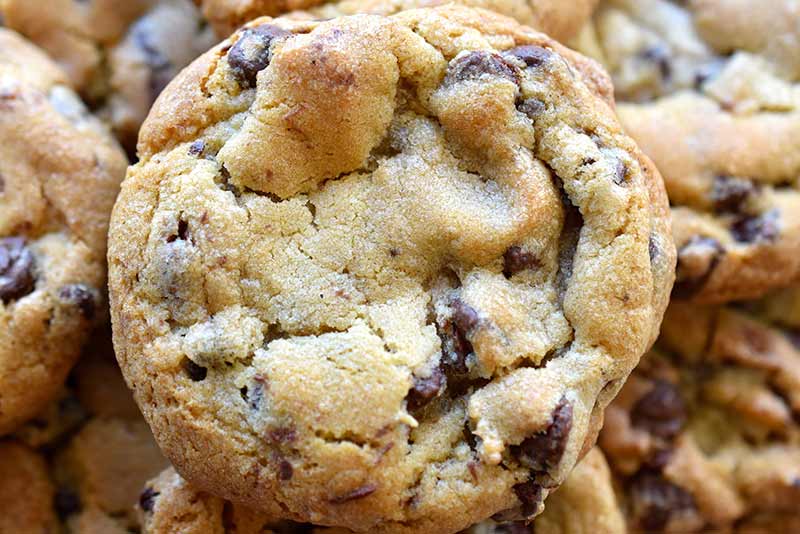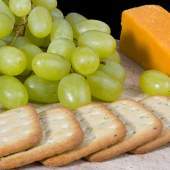Cookies

“Friend is someone to share last cookie with.”
— Cookie Monster, Sesame Street
It’s almost impossible to find a food about which everyone is in agreement. But there might be one: everyone loves cookies. Whether they’re known as “biscuits” (the UK and Australia), “keks” (Germany), “biscotti” (Italy), “galletas” (Spain), or something else, it’s a safe bet that nobody can resist a really good cookie, in any language. As the Girl Scouts once again ply their tasty fundraising wares (and wreak havoc with our New Year’s weight-loss resolutions), let’s take a closer look at them.
The word “cookie” is most likely derived from the Dutch word “koekje,” which translates to “small or little cake.” It’s a good descriptor, as they were originally used to test the oven temperature before baking a cake. A small amount of the batter would be formed into, well…a little cake, and baked to make sure the big cake wouldn’t burn during its turn in the oven. This was especially important when ingredients were at a premium.
Speaking of ingredients, one of them is essential for cookie-making: sugar. So it stands to reason that the cookie probably originated near the same area where sugar began to be used in cooking: 7th century Persia, which is now Iran. It was Alexander the Great who brought it to the Mediterranean and thence to Europe. By the Middle Ages, cookery books were filled with cookie recipes. One of the earliest of them appears to have been a form of shortbread; another was the aptly named hardtack which became a mainstay for travelers by ship, due to its long shelf-life. (Hopefully, they had something in which to dunk their hardtack, which were like rocks.)
Here are a few quick facts about some of the cookies we love today:
- Chocolate Chip — Hands down, the most popular cookie in America, with or without nuts. Their creator was Ruth Graves Wakefield, proprietor of the Toll House Inn in Whitman, Massachusetts, who came up with the “Toll House” cookie there in 1938. Bags of Nestle’s chocolate chips still carry her original recipe, which Ruth wisely sold to the company in exchange for a lifetime supply of baking chocolate.
- Oatmeal Raisin — We can probably thank that 19th century culinary maven Fannie Farmer for the original recipe for these, billed as “health food,” in 1896. Later, in a smart promotional strategy, a recipe was featured on every carton of Quaker Oats.
- Peanut Butter — African American botanist George Washington Carver was a big proponent of the peanut, developing all kinds of uses for it in recipes, including several for cookies incorporating crushed peanuts. It took the invention of peanut butter in the early 1920s to bring this cookie recipe into focus. It was Pillsbury that came up with the method of forming the batter into balls and flattening them with a fork, giving them their distinctive appearance.
- Oreos — It’s easy to assume that the Oreo was the first cookie of its kind, but that honor belongs to the Hydrox cookie, which made its debut in 1908, four years before the “Oreo Biscuit.” Invented in Manhattan and first sold in Hoboken, New Jersey, Oreos originally boasted a filling made from lard, but this was later replaced with partially hydrogenated vegetable oil, happily making the Oreo permissible for vegans.
- Sugar —The versatile sugar cookie has been around since at least the mid-1700s, brought to America by German Protestants who called it the Nazareth Cookie, named for a town in Pennsylvania. For decades, they were the state’s sole official cookie, and it goes well with Pennsylvania’s official state beverage: milk.
- Fig Newtons — There is more than one claimant for the invention of these popular (and healthy) cookies, but the Nabisco Company tells us that they were made possible in 1891 by a Philadelphian, James Henry Mitchell, when he invented a “duplex doughsheeting” machine that could quickly turn out these square, jam-filled bars. The “Newton” moniker came from a town near the first plant that tried out Mitchell’s invention: Newton, Massachusetts.
There are many, many more varieties, (including those ones your grandmother used to make). What’s YOUR favorite?





